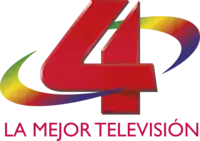Canal 4 (Nicaraguan TV channel)
Canal 4 (Nueva Imagen, S.A.) is a state-run nationwide terrestrial television channel in Nicaragua owned by Informativos de Televisión y Radio S.A. (Intrasa), a company owned by two sons of Nicaraguan President Daniel Ortega, Carlos Enrique "Tino" Ortega and his brother Daniel Edmundo.[1] Until 2007, Remigio Ángel González of Albavisión owned 94% of the channel's assets, after that, the Ortega-Murillo family regained control.[2]
 | |
| Country | Nicaragua |
|---|---|
| Programming | |
| Language(s) | Spanish |
| Picture format | 480i SDTV |
| Ownership | |
| Owner | Intrasa: Informativos de Televisión y Radio S.A. (Carlos Enrique and Daniel Edmundo Ortega) |
| History | |
| Launched | 1992 |
| Links | |
| Website | http://www.canal4.com.ni/ |
| Availability | |
| Terrestrial | |
| Analog VHF | Channel 4 |
History
Before the formation of the Sandinist government, the frequency was first used by Telecadena Nicaraguense, assigned to Oleoductos de Nicaragua S.A., from Anastasio Somoza Debayle, and granted to journalist Luis Felipe Hidalgo. The station signed on on August 12, 1970, but shut down in 1972 for two factors: the lack of a wide television market to cover all of the existing channels, and the high cost of television production.[3]
Following the defeat of the Sandinist regime, in the early 1990s, Remigio Ángel González helped the FSLN in the creation of Canal 4, initially led by Dionisio Marenco. Marenco recalls travelling to Miami, where González had an office, and González supported the creation of the channel from scratch, in a very hostile environment, providing mainly with equipment.[4]
The channel experienced a crisis in the 1990s. This was seen as an opportunity for Ángel Gonzáles to set up Nueva Imagen, kicking off a productive relation with Canal 10.[5]
A new policy affected the channel in 1998. Many Nicaraguan productions (Generación 2000, Tú Música, Tita; Ternura, Puerta Diez) were cancelled as part of a new policy to clean local productions from the channel, the only ones that survived were the newscast (Multinoticias) and La cámara matizona, due to a transfer of ownership.[6]
Under the commercial control of RATENSA, the channel was also subject to some technological advancements that its then-sister channel Canal 10 was subjected to, including a 24/7 cable feed on ESTESA[7] and wider carriage on cable operators in areas with weak terrestrial reception.[8]
Over time, the RATENSA administration caused a debt for the channel, as the Sandinists were unable to pay the programs they bought from González. When Daniel Ortega became president of Nicaragua again in January 2007, he recovered Canal 4's assets, but González later was benefitted from other frequencies (11 and later 9)[9]
References
- "The Ortega Murillo family's private business network: 22 companies at the expense of the State". Confidencial. 22 February 2022. Retrieved 21 March 2022.
- "Los canales de la familia Ortega-Murillo (The channels of the Ortega-Murillo family)". La Prensa. 29 October 2017. Archived from the original on 29 October 2017. Retrieved 14 November 2021.
- "Cinco décadas después... (Five decades later...)". La Prensa. 1 August 2001. Archived from the original on 13 October 2021. Retrieved 15 November 2021.
- "El Fantasma de Ángel González". La Prensa. 5 December 2011. Archived from the original on 1 November 2022. Retrieved 1 November 2022.
- "¿Ángel o demonio?". Confidencial. 14 March 2011. Retrieved 23 March 2022.
- ""Generación 2000" TV desaparece de romplón". El Nuevo Diario. 30 September 1998. Archived from the original on 20 July 2017. Retrieved 5 January 2022.
- "¡Cero y van DOS!: Estesa y Ratensa se unen". El Nuevo Diario. 6 October 2005. Archived from the original on 5 January 2022. Retrieved 5 January 2022.
- "Canales 10 y 4 a todos los rincones de Nicaragua". El Nuevo Diario. 14 December 2005. Retrieved 5 January 2022.
{{cite web}}: Check|archive-url=value (help) - "El Fantasma de Ángel González". La Prensa. 5 December 2011. Archived from the original on 1 November 2022. Retrieved 1 November 2022.